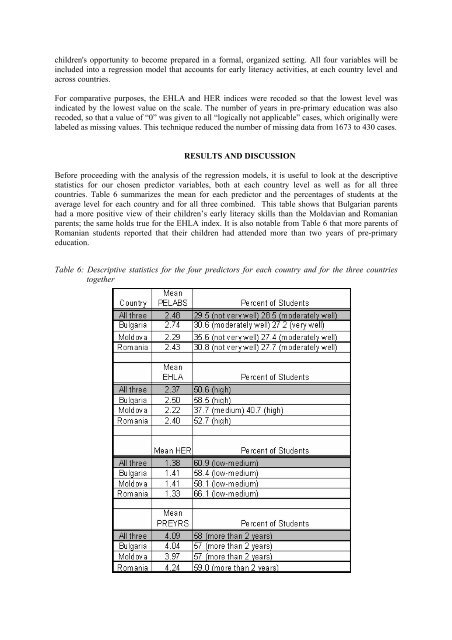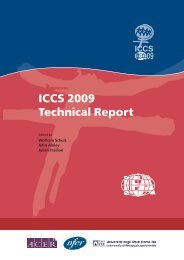THE EFFECTS OF EARLY LITERACY ACTIVITIES UPON ... - IEA
THE EFFECTS OF EARLY LITERACY ACTIVITIES UPON ... - IEA
THE EFFECTS OF EARLY LITERACY ACTIVITIES UPON ... - IEA
You also want an ePaper? Increase the reach of your titles
YUMPU automatically turns print PDFs into web optimized ePapers that Google loves.
children's opportunity to become prepared in a formal, organized setting. All four variables will be<br />
included into a regression model that accounts for early literacy activities, at each country level and<br />
across countries.<br />
For comparative purposes, the EHLA and HER indices were recoded so that the lowest level was<br />
indicated by the lowest value on the scale. The number of years in pre-primary education was also<br />
recoded, so that a value of “0” was given to all “logically not applicable” cases, which originally were<br />
labeled as missing values. This technique reduced the number of missing data from 1673 to 430 cases.<br />
RESULTS AND DISCUSSION<br />
Before proceeding with the analysis of the regression models, it is useful to look at the descriptive<br />
statistics for our chosen predictor variables, both at each country level as well as for all three<br />
countries. Table 6 summarizes the mean for each predictor and the percentages of students at the<br />
average level for each country and for all three combined. This table shows that Bulgarian parents<br />
had a more positive view of their children’s early literacy skills than the Moldavian and Romanian<br />
parents; the same holds true for the EHLA index. It is also notable from Table 6 that more parents of<br />
Romanian students reported that their children had attended more than two years of pre-primary<br />
education.<br />
Table 6: Descriptive statistics for the four predictors for each country and for the three countries<br />
together
















